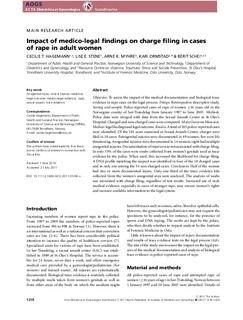| dc.contributor.author | Myhre, Arne Kristian | |
| dc.contributor.author | Hagemann, Cecilie Therese | |
| dc.contributor.author | Schei, Berit | |
| dc.contributor.author | Ormstad, Kari | |
| dc.contributor.author | Stene, Lise Eilin | |
| dc.date.accessioned | 2017-01-13T10:26:01Z | |
| dc.date.available | 2017-01-13T10:26:01Z | |
| dc.date.created | 2011-12-16T13:03:42Z | |
| dc.date.issued | 2011 | |
| dc.identifier.citation | Acta Obstetricia et Gynecologica Scandinavica. 2011, 90 (11), 1218-1224. | nb_NO |
| dc.identifier.issn | 0001-6349 | |
| dc.identifier.uri | http://hdl.handle.net/11250/2427214 | |
| dc.description.abstract | Objective. To assess the impact of the medical documentation and biological trace evidence in rape cases on the legal process. Design. Retrospective descriptive study. Setting and sample. Police-reported cases of rape of women ≥16 years old in the Norwegian county of Sør-Trøndelag from January 1997 to June 2003. Methods. Police data were merged with data from the Sexual Assault Center at St Olav’s Hospital. Charged and non-charged cases were compared.Main OutcomeMeasures. Medico-legal findings and legal outcome.Results.Atotal of 185 police-reported cases were identified. Of the 101 cases examined at Sexual Assault Center, charges were filed in 18 cases. Extragenital injuries were documented in 49 women; five were life threatening. Anogenital injuries were documented in 14 women; eight hadmultiple anogenital injuries.Documentation of injuries was not associatedwith charge filing. In only 33%of the cases were swabs collected fromwomen’s genitals used as trace evidence by the police. When used, this increased the likelihood for charge filing. A DNA profile matching the suspect was identified in four of the 18 charged cases and in only one among the 54 non-charged cases. Conclusions. Half of the women had one or more documented injury. Only one-third of the trace evidence kits collected from the women’s anogenital area were analyzed. The analysis of swabs was associated with charge filing, regardless of test results. Increased use of such medical evidence, especially in cases of stranger rape, may ensure women’s rights and increase available information to the legal system. | nb_NO |
| dc.language.iso | eng | nb_NO |
| dc.publisher | Wiley | nb_NO |
| dc.title | Impact of medico-legal findings on charge filing in cases of rape in adult women | nb_NO |
| dc.type | Journal article | nb_NO |
| dc.type | Peer reviewed | nb_NO |
| dc.source.pagenumber | 1218-1224 | nb_NO |
| dc.source.volume | 90 | nb_NO |
| dc.source.journal | Acta Obstetricia et Gynecologica Scandinavica | nb_NO |
| dc.source.issue | 11 | nb_NO |
| dc.identifier.doi | 10.1111/j.1600-0412.2011.01246.x | |
| dc.identifier.cristin | 869317 | |
| dc.description.localcode | (c) 2011 The Authors | nb_NO |
| cristin.unitcode | 194,65,20,0 | |
| cristin.unitname | Institutt for samfunnsmedisin | |
| cristin.ispublished | true | |
| cristin.fulltext | postprint | |
| cristin.qualitycode | 1 | |
